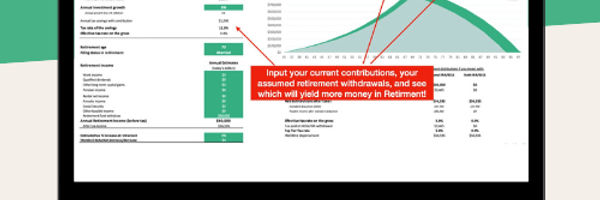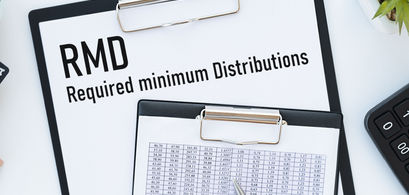In this article, we're going to discuss minimum required distributions, or MRDs. For certain retirement accounts, including the 401(k), 403(b), and the Traditional IRA, minimum distributions are required. Here we'll discuss the calculation of this distribution, and the exact MRD rules to follow.

Roth IRA or 401k? This template will answer your questions.
With this template, you will get:
All DFY, simply add your details
Charts for comparison and clear answer
Easily update for any year (2023, 2024, 2025, etc…)

What is a Minimum Required Distribution?
The purpose of a minimum required distribution is to make sure taxpayers actually use their retirement money, and not leave it behind as part of their estate. The Internal Revenue Service monitors these minimums to make sure the money in an Employer Sponsored Retirement Plan or ERSP such as a 401(k) plan or 403(b) account is used for retirement, and not earmarked to be inherited by others.
Traditional IRAs are also subject to minimum required distribution rules; however, with Roth IRAs minimum distributions are not required. The reason Roth IRAs do not have a MRD is quite simple: income taxes. The money withdrawn from a 401(k), 403(b), and the tax-deferred portion of a Traditional IRA is subject to federal income taxes. Roth IRA withdrawals, or qualified distributions, are not subject to this tax. The federal government would like to collect this income tax, and by creating a MRD, it is removing a potential tax shelter. If this did not occur, the money left in these retirement accounts would pass on to the owner's heirs, and the inheritance tax laws could allow the money to pass to heirs tax-free.
MRD Rules
Under most employer sponsored plans, individuals must take their first minimum withdrawal from their account by April 1st of the year following the year that they reach age 70 1/2. Anyone delaying taking their first MRD until April 1st must take their second MRD by December 31st of that same year.
Exceptions to the MRD Rules
Individuals age 70 1/2, that are still working, and not a 5% owner of their employer, may not be required to take a minimum required distribution. This exception applies as long as they remain working. A second exception to the MRD rule may also apply if an individual participated in a 403(b) plan prior to December 31, 1986. In that case, the plan may allow accountholders to defer taking a minimum distribution until age 75.
Tax Penalties
It's important to understand these MRD rules because not taking a distribution can be costly. The IRS can impose a 50% tax penalty on any amount that should have been withdrawn via a minimum required distribution. That 50% tax penalty is in addition to the "regular" federal income tax due on the distribution.
The IRS can impose a 50% tax penalty on any amount that should have been withdrawn via a MRD in addition to the "regular" federal income tax due on the distributionMoneyzine Editor
Revised Rules
Back in April 2002, the IRS revised the minimum required distributions for IRAs, 401(k) accounts, and 403(b) plans. These rules first became effective in January 2003. These new rules revised the life expectancy tables previously used, essentially extending the life expectancy factor and thereby modifying the MRD calculation. By increasing the life expectancy factor, retirement accountholders were required to take smaller distributions.
Excess Distributions
Keep in mind this is a discussion of the minimum distributions. There is nothing to prevent anyone from taking more than the minimum. However, an individual that takes more than the minimum in one year does not get a "credit" in subsequent years. The calculation of a MRD does not allow for such credits. Finally, rollover rules do not apply to MRDs. These distributions cannot be rolled-over into another retirement plan.
MRD Calculations
In general, the minimum required distribution is calculated by dividing the market value of the tax deferred retirement money as of December 31st of the prior year by the individual's life expectancy factor taken from the proper IRS table.
Example MRD Calculation
Let's say that the market value of the tax deferred portion of Joe's IRA is $100,000, and he is 76 years old. Using the Uniform Lifetime Table, the calculation of his MRD is: = Market Value of Deferred IRA / Distribution Period Factor Or $100,000 / 22 = $4,545.45 If a spouse or beneficiary is more than 10 years younger than the accountholder, then the Joint Life Expectancy Table is used when calculating an MRD. The factors found on this table will result in smaller distributions relative to the Uniform Lifetime Table. We offer a minimum required distributions calculator that can be used to run through additional examples.



